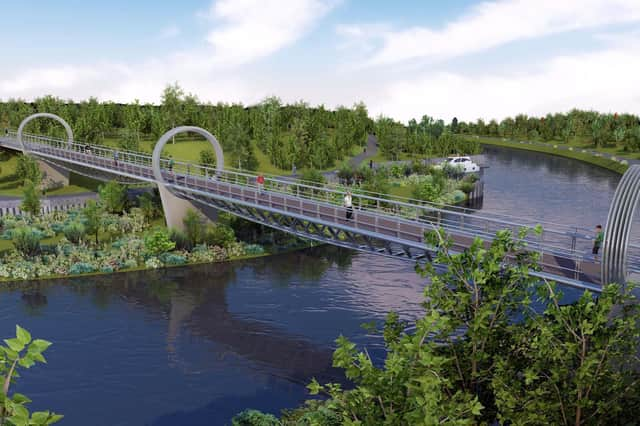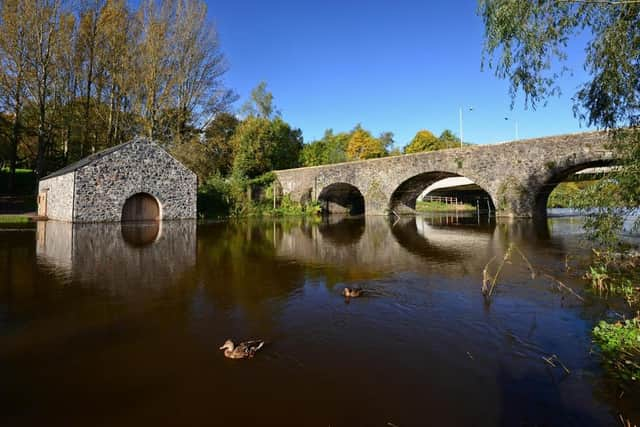The Lagan Valley Regional Park needs to be protected from urban housing


To many it is an introduction to what has been a magic place, and to which the new bridge is officially the gateway — the upstream part of the Lagan Valley Regional Park (LVRP).
The Lagan Valley Regional Park, though in existence earlier, was designated in 2001, and was officially defined as a special area of scenic character and recreation, to be protected and enhanced.
Advertisement
Hide AdAdvertisement
Hide AdThe statutory Belfast Urban Area Plan 2001, confirmed the importance of the park and said land use policies in it would protect existing recreation and open space areas.


The remaining areas within the park, mostly used for agriculture, would be protected from urban development.
The latest five year development plan for the park finishes this year, and already the park authorities are welcoming the gateway development as a success. But not everybody loves it.
The bridge and lock and associated works have cost more than £3 million. Some think the high steel bridge and the new lock and concrete surrounds constitute an unnecessarily ‘hard’ and massive intrusion into a rural landscape.
Advertisement
Hide AdAdvertisement
Hide AdThe earth-shifting needed to site the foundations of the bridge back from the marshy Annadale bank has contributed to considerable alteration of large parts of the old landscape.


That included some reminders of the 135 acre demesne and pleasure ground of Annadale Hall which stood there for two centuries, but which had in the 20th century been left to some cattle grazing and a return to nature, aided by planting of trees in dense copses, to provide habitats for birds and other species. Several of these have been bulldozed away over the past two years and today Lagan Lands East, as it was called, looks more like a pleasant urban park than an untamed rural landscape.
Still, the bridge is there, is very useful and if you share a passage over it with an even slightly portly jogger you will have all the thrill of a fairground ride. The bridge wobbles quite noticeably, alarmingly to some, and the more timid rush to grasp the side rails, to the merriment of stouter souls.
But whatever the impact of the Gateway Project on the regional park it is nothing compared to the body blow the park has suffered in 2022 — the worst since its designation — the sacrifice of two good meadows to the building of possibly 40 houses inside the boundaries of the park.
Advertisement
Hide AdAdvertisement
Hide AdSo much for the commitment to protect such meadows from urban development.
The existence of a decades old permission for fewer houses on the site did not mean permission had to be granted for many more now.
Ironically 2022 has seen what threatens to be the abrupt abandonment of another long-term aim of the LVRP, to link the gateway to Belvoir Forest Park.
The path that has enabled hundreds over many decades to make that pleasant trek, over rough ground has all but disappeared.
Advertisement
Hide AdAdvertisement
Hide AdEarlier this year the short piece inside the gateway project was left to become impassable.
Recently it has been cleared, but still leads nowhere, or rather it leads to a building site.
The path to Belvoir was never a towpath, for it wandered far from the river — a rough path, often muddy in winter; its status was not clear, but it had some official recognition by being maintained in parts in its early stages and by the officially provided stile that assisted walkers in exiting the publicly-owned lands.
A pathway on that side of the Lagan is not just a means of getting to Belvoir.
Advertisement
Hide AdAdvertisement
Hide AdAlready the towpath on the other side of the river is at times dangerously overcrowded on Saturdays and Sundays. A pathway on the Down side would ease the pressure.
The path to Belvoir is officially termed Phase Two of the gateway project and as long ago as May 2021 it was announced that a design team for this phase had been appointed.
There has been little sign of progress since, and it seems there is no agreement on the route the path might take. One of the key funders of the whole scheme, Ulster Garden Villages, made the connection to Belvoir a key priority. It seems there is no guarantee that there will ever be pathway on that side to Belvoir.
Worse may be to come, rumour has it that the developers of the housing project at Hampton are pressing for permission to build close to the river’s edge.
Advertisement
Hide AdAdvertisement
Hide AdRumour has it too that there may be a proposal to build an access road from the site at Hampton onto Annadale Avenue or more likely Annadale Embankment. This would presumably follow the route of the main path in at the sharp bend on the embankment.
Such a road joining Annadale at that point makes no sense from road safety or traffic management aspects. Some may argue that it would lessen the inevitable increased flow of vehicles trying to enter and leave Hampton Park and join the traffic rushing down or up to the Ormeau/Saintfield Roads arterial approach to the city.
Presumably the question of a single access, via Hampton Park, to the new housing development was seriously considered, and permission was given for so many houses despite the consequent impact on the volume of traffic using Hampton Park.
To give the nod now to a road through the heart of a nature reserve, of a rural parkland meant to offer an escape from the urban madhouse would itself be madness.
Advertisement
Hide AdAdvertisement
Hide AdOur friend rumour, who is seldom wrong, reports another threat. He says feelers have been put out about more housing within the park.
If the new road out to Annadale was built along the line of what was, and still is, the main entrance into the gateway, it would run through portions of the gateway area which have been left untouched by recent works. These happen to be among the richest parts of the park in terms of wildness and nature, home to badgers, foxes, squirrels and, until a few years ago, bats galore.
This month, my wife and I were thrilled to see an otter a few yards away, trying to find his way back down into the river from the concrete surrounds of the lock. This was the first time we had seen an otter in the LVRP in the 36 years we have lived on its fringe and greatly enjoyed wandering through it.
These developments and rumours relating to the park have excited comparatively little public notice. The park’s Advisory Council has a statutory role to advise on such planning matters. Has it vigorously defended the park?
Advertisement
Hide AdAdvertisement
Hide AdHave people generally been too preoccupied with the pandemic, and politicians with arguing over politics?
Elected local representatives were given more powers in planning decisions some years ago.
They don’t seem to have used them so far in defending one of the best assets the city has.
Policy development within the regional park is managed by a Board of Directors, on which the councils of Belfast and Lisburn/ Castlereagh each supply three members.
Advertisement
Hide AdAdvertisement
Hide AdDoes the Belfast City Council have powers of compulsory purchase over the land needed for the path? Might that be a surer path than doing deals with developers.
l Dennis Kennedy is a former deputy editor of the Irish Times. He lives on the fringe of the Lagan Valley Regional Park, and in the 1990s was on the park’s Advisory Council